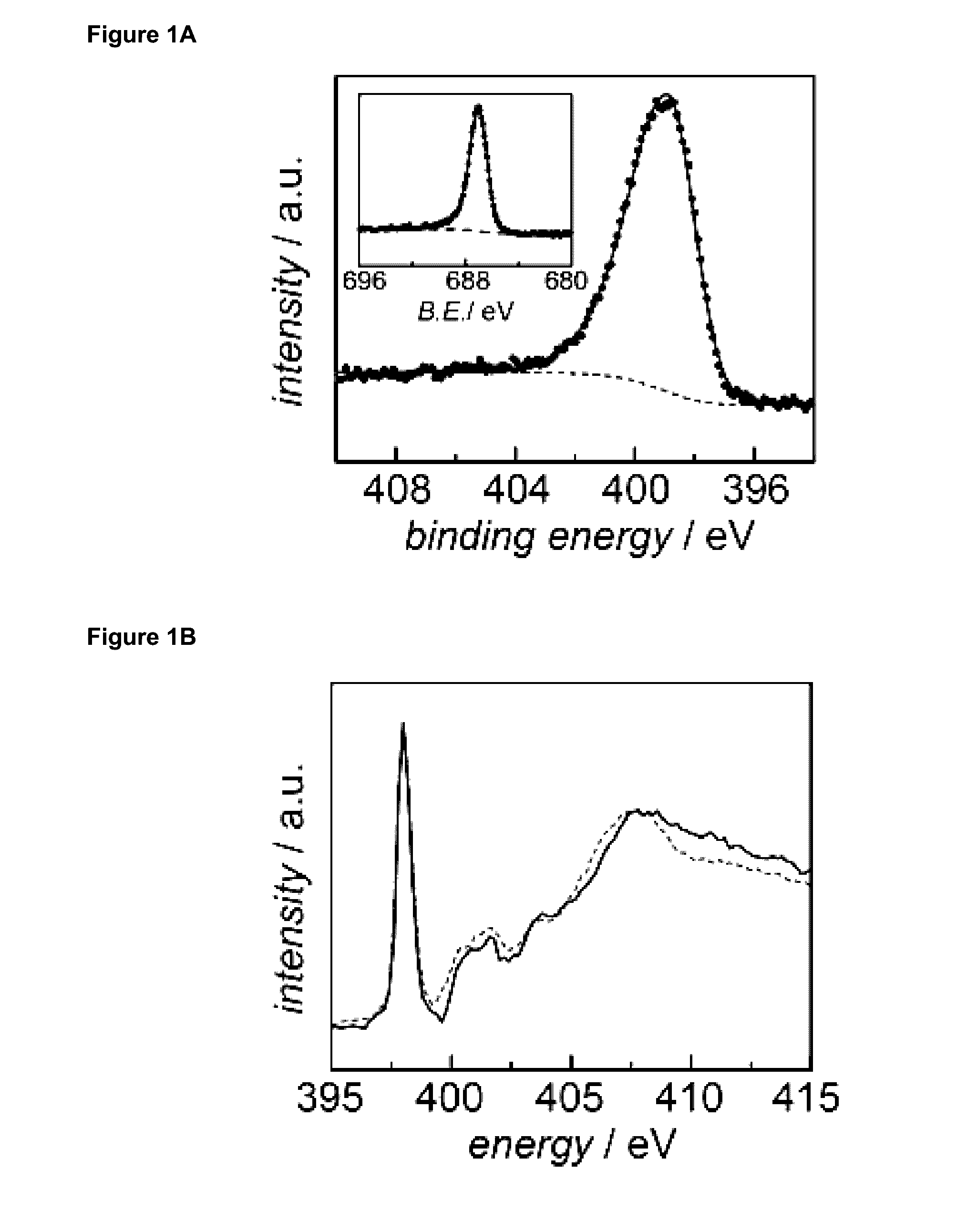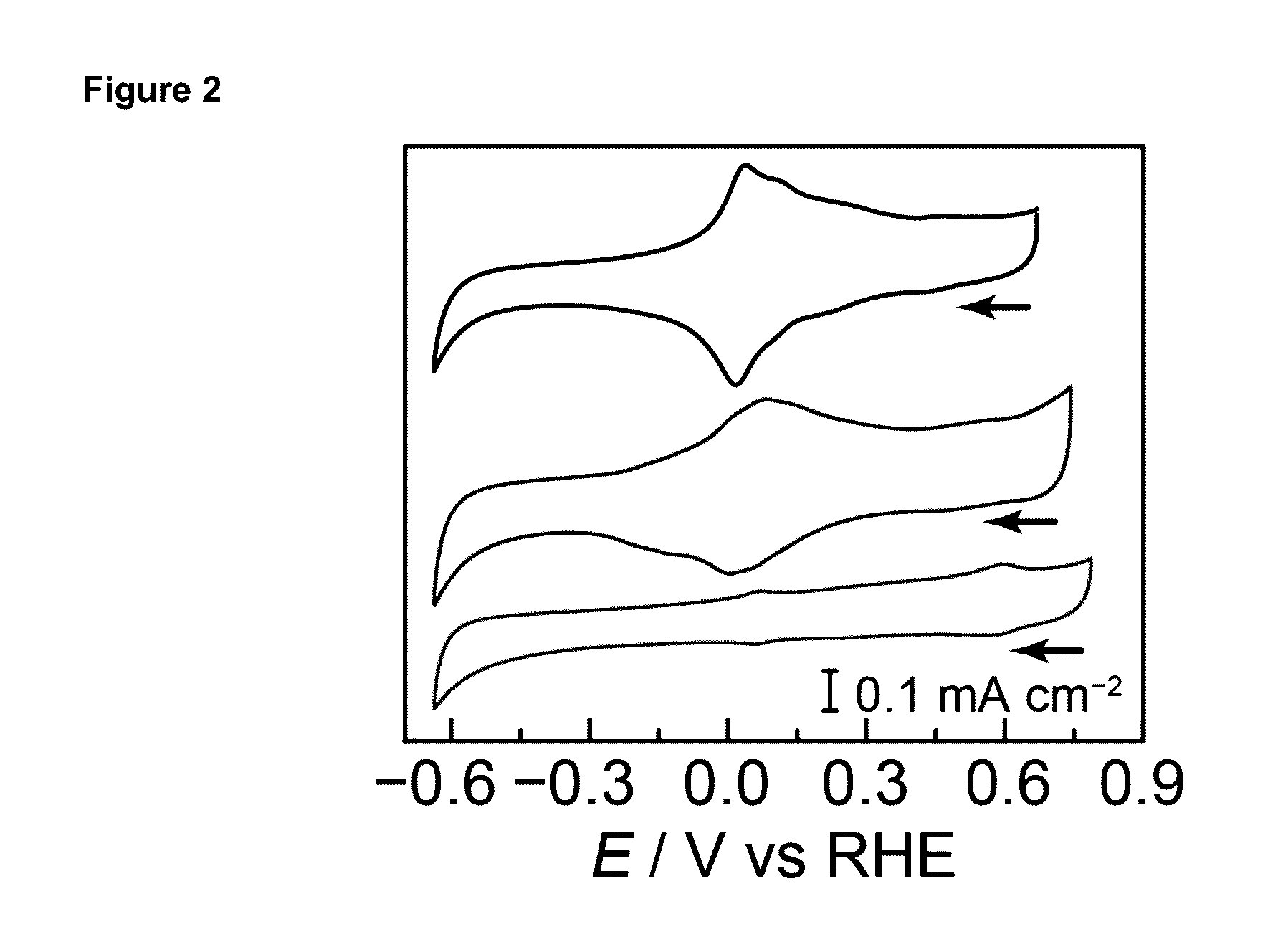Molecularly tunable heterogeneous catalysts by edge functionalization of graphitic carbons
a graphitic carbon and heterogeneous catalyst technology, applied in the field of molecularly tunable heterogeneous catalysts by edge functionalization of graphitic carbons, can solve the problems of limited electrochemical stability range, difficult to achieve similar control with heterogeneous, and lack of surface connection chemistries that are both robust and well-defined, so as to prevent bimolecular deactivation pathways and lower energy catalytic pathways.
- Summary
- Abstract
- Description
- Claims
- Application Information
AI Technical Summary
Benefits of technology
Problems solved by technology
Method used
Image
Examples
example 1
Synthesis of Pyrazine-Modified Glassy Carbon Electrodes
[0492]To facilitate systematic studies of oxygen reduction catalysis, GCPs were synthesized on glassy carbon (GC) electrodes, which contain graphitic domains with a high edge-to-basal plane ratio. To clean the GC surface and increase the population of surface quinone groups, electrodes were subjected to brief anodic treatment following literature methods. The anodized glassy carbon electrodes were then treated with the requisite phenylenediamine precursor in ethanol at 60° C. for 12 hours, after which the electrodes were rinsed with copious amounts of pure ethanol, water, and 0.1 M HClO4. The final acid rinse was used to ensure removal of physisorbed diamines and to hydrolyze surface imine moieties generated via condensation with isolated surface carbonyls or para-quinone moieties. By employing differentially substituted diamines, three distinct GCP catalysts, 1-3, were obtained (Scheme 1).
[0493]All electrochemical experiments w...
example 2
XPS Curve Fitting for Pyrazine-Modified Graphite
[0497]To characterize the surface species generated by the synthetic protocol in Example 1, 1-3 were examined via X-ray photoelectron spectroscopy (XPS). Data for 1 is shown in FIG. 1A, data for 2 and 3 are shown in FIG. 5A and FIG. 5B, and fitting parameters are summarized in Table 3). Upon functionalization of the glassy carbon electrode with 1′, a pronounced peak was observed in the N 1s XPS spectrum at 398.9 eV binding energy that is absent in the native electrode (FIG. 6). This peak position is in line with that expected for pyridinic nitrogen moieties on N-containing carbons. In addition, a sharp F 1s peak was observed at 687.0 eV binding energy (FIG. 1A inset) and XPS spectra revealed an N / F ratio of −2, in line with the atomic composition of 1′. These same spectral features were also observed in the N 1s spectra for 2 and 3, with an additional peak observed at 401.7 eV for 3 attributed to the pyridinium nitrogen (FIG. 5). Toget...
example 3
Synthesis of Pyrazine-Modified High-Surface Area Carbons
[0499]To gain further insight into the local bonding environment of nitrogen centers, 1′-treated high surface area graphitic carbon, Monarch 1300, was probed by nitrogen K-edge X-ray absorption near edge structure (XANES) spectroscopy (FIG. 1B, solid line). Combustion analysis of this high surface area variant of 1 revealed an increase in N content from 0.1 to 1.3 mass % (Table 4), consistent with incorporation of 1′ into the high surface area carbon. The XANES spectra of the modified carbon displayed a sharp feature at 398.0 eV assigned to the 1s-π* transition. This was followed by a series of broad features spanning 407 eV to 409 eV which are assigned to 1s-σ* transitions. An excellent match was observed between the spectrum of phenazine (FIG. 1B, dashed line) and high surface area carbon treated with 1′ (FIG. 1B, solid line). The observed spectral features were distinct from those observed for free aryl amines in 1′ (FIG. 7)...
PUM
| Property | Measurement | Unit |
|---|---|---|
| electron mobility | aaaaa | aaaaa |
| Faradaic efficiency | aaaaa | aaaaa |
| Faradaic efficiency | aaaaa | aaaaa |
Abstract
Description
Claims
Application Information
 Login to View More
Login to View More - R&D
- Intellectual Property
- Life Sciences
- Materials
- Tech Scout
- Unparalleled Data Quality
- Higher Quality Content
- 60% Fewer Hallucinations
Browse by: Latest US Patents, China's latest patents, Technical Efficacy Thesaurus, Application Domain, Technology Topic, Popular Technical Reports.
© 2025 PatSnap. All rights reserved.Legal|Privacy policy|Modern Slavery Act Transparency Statement|Sitemap|About US| Contact US: help@patsnap.com



